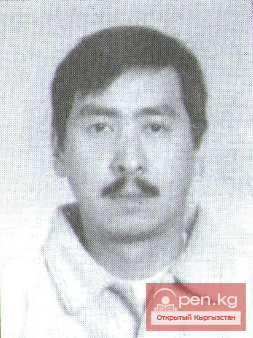Spring of '74 at the Tashkent Festival
On a sunny May morning, the festival participants were guests of Uzbek filmmakers and took a trip to "Uzbekfilm." Back in 1924, a small studio was opened in the building of the Sheikhantaur Madrasah. Today, "Uzbekfilm" is one of the largest studios in Soviet Central Asia, a contemporary of Soviet Uzbekistan. In 1984, it, like other Soviet Central Asian republics: Kyrgyzstan, Turkmenistan, and Tajikistan, will celebrate its 60th anniversary. Along with its native republic, Uzbek cinema has grown, and the experience of the festival hosts is highly instructive for filmmakers from developing countries in Asia and Africa.
...In the numerous, endlessly long corridors of "Uzbekfilm," history lives on. Large photographs on the walls are frames from films released by the studio over 50 years.
And in this unique gallery are familiar faces of compatriots: Bakken Kydykeeva in the film of the oldest Uzbek director Kamil Yarmatov "Horsemen of the Revolution," Bolot Beishenaliev in "Red Sands," Suymenkul Chokmorov in the roles of Nizametdin Khojaev in "The Extraordinary Commissioner" and commander Maksumov in "The Seventh Bullet" directed by Alp Khamraev.
A few years have passed since the meeting of Uzbek director Ali Khamraev and Kyrgyz artist Suymenkul Chokmorov at the V International Film Festival in Moscow, where Chokmorov made his film debut playing Bakhtygul in "The Shot at the Karash Pass." That was the beginning of the creative friendship between Khamraev and Chokmorov, which produced interesting films.
— Chokmorov is that bright, sharp, and original actor,— says L. Khamraev,— who revives and renews the heroic tradition in our cinema. He is a film hero in the highest, most beautiful sense of the word. He cannot tolerate falsehood in life or art. And he always demands from the director a clearly and precisely defined task, a precise understanding of the image. I believe that the school of painting has instilled in Suymenkul this demand for himself, artistic intuition, and a sense of truth.
A testament to Chokmorov's creative growth was a role of a completely different nature, an image unlike those he had created before — Akhangul in the new film by Tolomush Okeeva and Kadyrzhan Kydyraliev "Fierce," based on the story by Mukhtar Auezov "Gray Fierce," which was recognized as one of the best films of the festival and was well received by the audience. After the screening, in the foyer of the Okeeva and Chokmorov Arts Palace, they were surrounded by viewers and colleagues from different countries of the world — congratulating them, asking for autographs, and posing many questions.
Brief notes in a notebook... A young pilot, having waited for the moment, finally decided to ask Suymenkul: "Comrade Chokmorov, tell me honestly, were you scared? After all, you weren't filming with cats..."
A representative of one of the foreign firms, who had seen "Fierce" the day before at screenings organized by "Sovexportfilm," congratulated our compatriots on their excellent work, informing them that their firm had bought the film, and when Okeeva asked, the foreigner replied, smiling, in Russian: "Algeria" ...
About the film "Fierce" as a vivid example of fruitful creative collaboration between two Central Asian studios — "Kyrgyzfilm" and "Kazakhfilm" — spoke at the closing press conference the head of the Soviet delegation — Deputy Chairman of the Soviet Committee for Solidarity of Asian and African Countries, Chairman of the Board of the Union of Cinematographers of Kyrgyzstan Chingiz Aitmatov, once again emphasizing the idea of the feasibility of joint work by filmmakers from different republics and countries.
I ask questions to the famous Soviet documentary filmmaker, People's Artist of the USSR, director of the Tashkent Studio of Documentary and Popular Science Films Malik Kayumov: what impression did Kyrgyz documentary films leave on him?
— I remember "The Post" from the festival in Leipzig, where I was a jury member,— says Kayumov. — I hold this film very dear, I love it. And in general, I have a special relationship with Kyrgyzstan; it is the republic of my youth... I worked in Frunze, at the correspondent point of the Tashkent studio "Soyuzkinokhronika," shooting and editing materials about Kyrgyzstan, its people during the awakening of the nation to a new life, to the light... Such things are unforgettable. Our brotherly peoples have been and will be together. And, of course, we must work together. We will always be together,— smiles Malik Kayumovich...
The festival is a festival, a celebration is a celebration, but work did not wait. The day after the screening of "Fierce," filming of "Red Apple" began — Okeeva and Chokmorov flew home. And a few days later, so did Bekesh Abdildaev: it was necessary to finish editing the documentary film about Zuurakan Kainazarova. And those who remained had new ideas...
It was in Tashkent that American actress and director Loretta Pauker decided to shoot a film about the USSR and show it on New York television.
...People's Artist of the USSR, Hero of Socialist Labor, director K. Yarmatov, together with playwright M. Melkumov, were already finishing the script for a film about Vladimir Ilyich Lenin — "Days of Anxiety and Hopes."
In a few years, at the next Tashkent festivals, Kyrgyz filmmakers will bring "Red Apple" and "White Steamboat." But then, in the spring of '74, work on them was in full swing...
Evaluation of Kyrgyz Art by Participants of the Tashkent Festival of 1974. Television and Cinema of Kyrgyzstan in the 70s—early 80s. Part -10











































